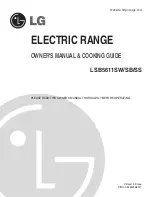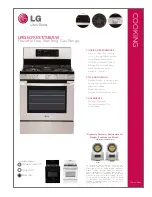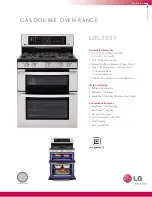
1. Place the shelf in A or B position. No preheating
is necessary.
2. Check the weight
of the meat. Place it
fat-side-up (or
poultry breast side-
up), on a roasting
grid in a shallow pan.
The melting fat will
baste the meat. Select
a pan as close to the size of the meat as possible.
(The broiler pan with grid is a good pan for this.)
3. Turn the OVEN TEMP
knob to the temperature
you desire.
4. After roasting is complete,
turn the OVEN TEMP knob
to OFF.
(Knob appearance may vary)
50
0
45
0
40
0
350
300
25
0
20
0
W
M
OFF
BROIL
A
B
ADJUST THE OVEN THERMOSTAT—
DO IT YOURSELF!
You may find that your new oven cooks differently
than the one it replaced. We recommend that you
use your new oven for a few weeks to become more
familiar with it, following the times given in your
recipes as a guide.
If you think your new oven is too hot or too cold,
you can adjust the thermostat yourself. If you think
it is too hot, adjust the thermostat to make it cooler.
If you think it is too cool, adjust the thermostat to
make it hotter.
We do not recommend the use of inexpensive
thermometers, such as those found in grocery stores,
to check the temperature setting of your new oven.
These thermometers may vary 20–40 degrees.
To Adjust the Thermostat:
1. Pull the OVEN TEMP knob off the shaft, look
at the back of the knob and note the current setting
before making any adjustments.
2. Loosen both screws on the back of the knob.
3. To increase the oven temperature, move the
pointer 1 notch toward the words “MAKE
HOTTER”.
To decrease the oven temperature, turn the
pointer 1 notch toward the words “MAKE
COOLER”.
Each notch changes the temperature by 10 degrees
Fahrenheit.
4. Tighten the screws.
5. Replace the knob, matching the flat area of the
knob to the shaft.
50
0
45
0
40
0
350
300
25
0
20
0
W
M
OFF
BROIL
+20
° 0° -20
MA
KE
MAK
E
HO
TTE
R
COOL
ER
A
PP
ROX
. 10° PER N
OT
CH
O
V
EN
TEMPERAT
UR
E
L
O
O
S
EN
SCREWS AND
RO
TA
T
E
TO
ADJUS
T
Back of
OVEN TEMP knob
(Knob appearance may vary)
Front of
OVEN TEMP knob
Pointer
ROASTING
Roasting is cooking by dry heat. Tender meat or
poultry can be roasted uncovered in your oven.
Roasting temperatures, which should be low and
steady, keep spattering to a minimum.
Roasting is really a baking procedure used for meats.
Therefore, oven controls are set for Baking. (You may
hear a slight clicking sound, indicating the oven is
working properly.)
Most meats continue to cook slightly while standing,
after being removed from the oven. The standing time
recommended for roasts is 10 to 20 minutes. This
allows roasts to firm up and makes them easier to
carve. The internal temperature will rise about
5° to 10°F.; to compensate for the temperature rise,
if desired, remove roast from the oven sooner
(at 5° to 10°F. less than the temperature in the guide).
Remember that food will continue to cook in the hot
oven and therefore should be removed when the
desired internal temperature has been reached.
20
Summary of Contents for JBC17
Page 37: ...37 NOTES The Problem Solver ...
Page 38: ...38 NOTES ...
















































